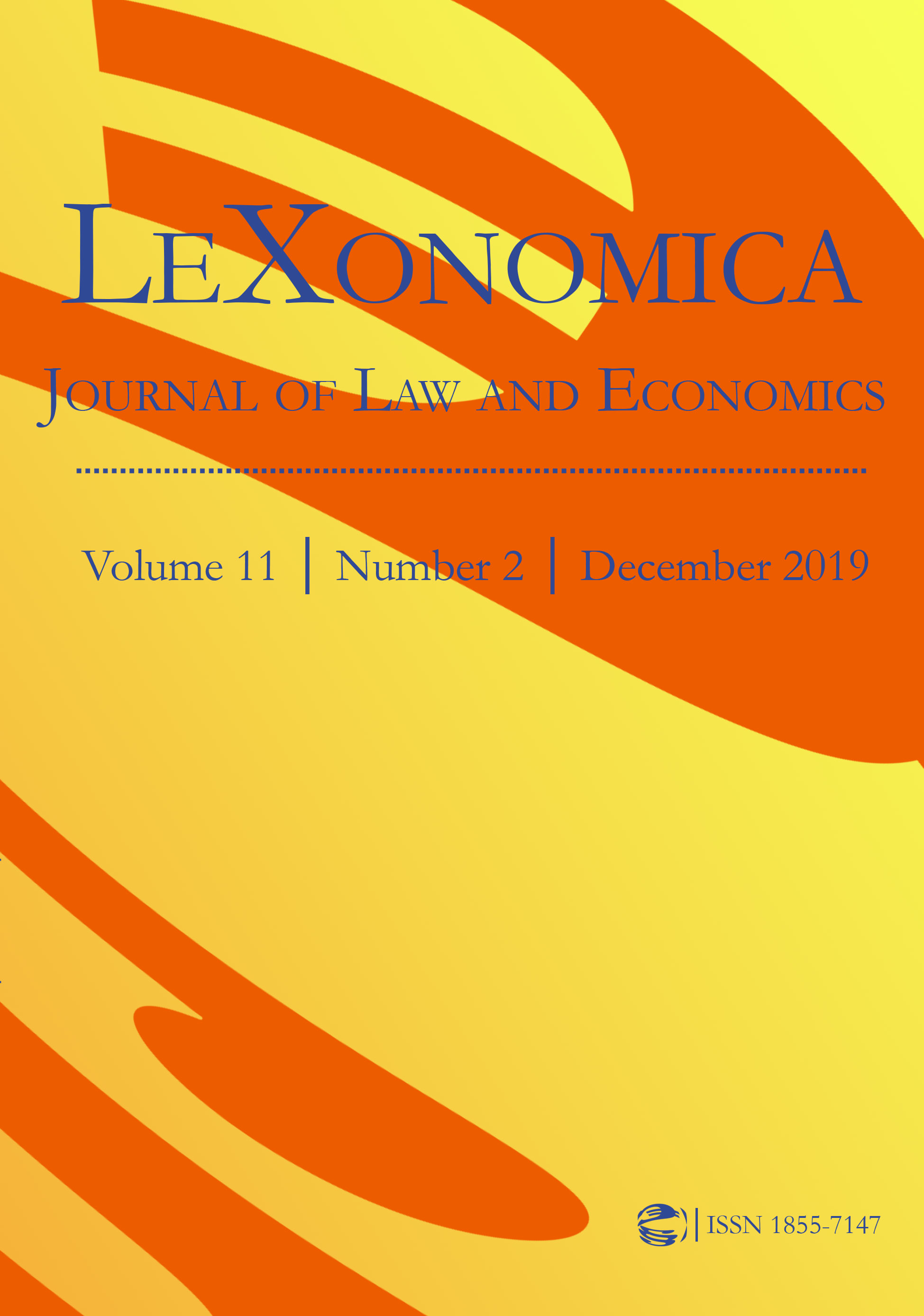Triple Helix as a Social and Legal Phenomenon of Regional Innovative Development: on the Example of the Penza Region as an Average Subject of the Russian Federation
DOI:
https://doi.org/10.18690/lexonomica.11.2.175-194.2019Keywords:
law, government, science, cluster, economy, strategy, triple helix model of innovationAbstract
The experience of developed countries (Germany, USA, Scandinavia) shows that scientific, technical and innovation activities contribute to modernization of the economy, and are a stabilizing factor in social development. Coordination and structuring of such a relationship at the legislative level is the basis of strategic planning of Russia and its regions. Today, the creation of new constitutional, social and legal foundations of strategic development affects every constituent entity of the Russian Federation. The article analyses the need to fill a gap in legal research, the development of scientific and theoretical provisions related to innovation. The Penza region is a typical constituent entity of the Russian Federation, taking into account the peculiarities of the geographical location, the number and well-being of the population, the development of the business sector, and the level of scientific potential. Standard socio-economic problems of the state, as well as the resulting status of innovative development are characteristic for the Penza region. In the article particular attention is paid to the non-hierarchical way of coordinating “government-business-science” relations in the context of the Triple Helix model, which plays a key role in the innovation process as a social and legal mechanism of development of economy.
Downloads
References
Almeida, M., Etzkowitz, H. and Mello, J. (2010) Social Innovation in a Developing Country: Invention and Diffusion of the Brazilian Cooperative Incubator. International Journal of Technology and Globalization, 6(3), pp. 206−224. DOI: https://doi.org/10.1504/IJTG.2012.048326.
Ankrah, S. N., Burgess, T. F., Grimshaw, P. and Shaw, N. E. (2013) Asking both university and industry actors about their engagement in knowledge transfer: What single group studies of motives omit. Technovation, 33(2–3), pp. 50−65. DOI: https://doi.org/10.1016/j.technovation.2012.11.001.
Asheim, B., Grillitsch, M. and Trippl, M. (2016) Regional innovation systems: past-presentfuture. In R. Shearmu, Ch. Carrincazeaux, and D. Doloreux (Eds.), Handbook on the Geographies of Innovation, pp. 45−62 (Cheltenham: Edward Elgar Publishing).
Borch, O. J. and Solesvik, M. (2016) Partner selection versus partner attraction in R&D strategic alliances: the case of the Norwegian shipping industry, International Journal of Technology Marketing, 11(4), pp. 421−439. DOI: https://doi.org/10.1504/IJTMKT.2016.079726.
Carayannis, E. G. and Grigoroudis, E. (2014) Linking innovation, productivity and competitiveness: implications for policy and practice. The Journal of Technology Transfer, 2, pp. 199−218. DOI: https://doi.org/10.1007/s10961-012-9295-2.
Carayannis, E. G. and Grigoroudis, E. (2016) Using multiobjective mathematical programming to link national competitiveness, productivity, and innovation, Annals of Operations Research, 247(2), pp. 635−655. DOI: https://doi.org/10.1007/s10479-015-1873-x.
Carayannis, E. G., Grigoroudis, E., Sindakis, S. and Walter, C. (2014) Business model innovation as antecedent of sustainable enterprise excellence and resilience, Journal of the Knowledge Economy, 3(5), pp. 440−463. DOI: https://doi.org/10.1007/s13132-014-0206-7.
Dudin, M. N., Lyasnikov, N. V. and Senin, A. S. (2014) Triple Helix model and its appliance in the context of innovative development of businesses and formation of ‘Creative Class’. European Researcher, 7(1), pp. 1249−1256. DOI: https://doi.org/10.13187/issn.2219-8229.
Etzkowitz, H. (2012) Triple Helix Clusters: Boundary Permeability at University-IndustryGovernment Interfaces as a Regional Innovation Strategy. Environment & Planning C: Government and Policy, 30(5), pp. 766−779.
Foray, D., Goddard, J., Beldarrain, X. G., Landabaso, M., McCann, P., Morgan, K., Nauwelaers, C. and Ortega-Argiles, R. (2012) Guide to Research and Innovation Strategies for Smart Specialisations (RIS3) (Luxembourg: Publications Office of the European Union), 121 pp. DOI: 10.2776/65746.
Gackstatter, S., Kotsemir, M. and Meissner, D. (2014) Building an innovation-driven economy – the case of BRIC and GCC Countries. Foresight, 16(4), pp. 293−308.
Höglund, L. and Linton, G. (2017) Smart specialization in regional innovation systems: a quadruple helix perspective, R&D Management, 1(48), pp. 60−72. DOI: https://doi.org/10.1111/radm.12306.
Howaldt, J., Kaletka, C., Schröder, A., Rehfeld, D. and Terstriep, J. (2016) Mapping the World of Social Innovation. Key Results of a Comparative Analysis of 1.005 Social Innovation Initiatives at a Glance, https://www.si-drive.eu/wpcontent/uploads/2016/12/SI-DRIVE-CA-short-2016-11-30-Druckversion.pdf.
Klievink, B. and Janssen, M. (2014) Developing multi-layer information infrastructures: Advancing social innovation through public–private governance, Information Systems Management, 31(3), pp. 240–249. DOI: https://doi.org/10.1080/10580530.2014.923268.
Leydesdorff, L. (2012) The Triple Helix, quadruple helix, …, and an N-tuple of helices: explanatory models for analyzing the knowledge-based economy?, Journal of the Knowledge Economy, 1(3), pp. 25−35. DOI: https://doi.org/10.1007/s13132-011-0049-4.
Lilles, A. and Rõigas, K. (2015) How higher education institutions contribute to the growth in regions of Europe?, Studies in Higher Education, 42(1), pp. 1−14. DOI: https://doi.org/10.1080/03075079.2015.1034264.
Markkula, M. and Kune, H. (2015) Making smart regions smarter: smart specialization and the role of universities in regional innovation ecosystems, The Technology Innovation Management Review, 10, pp. 7−15.
Mathe, K. M. (2013) Agricultural growth and food security: Problems and challenges international, Journal of Research in Commerce, Economic & Management, 7(3), pp. 131−137.
Meissner, D. (2014) Approaches for developing national STI strategies, STI Policy Review, 5(1), pp. 34−56.
Midtkandal, I. and Sörvik, J. (2012) What is Smart Specialisation?, Nordregio News, 5, https://archive.nordregio.se/en/Metameny/Nordregio-News/2012/SmartSpecialisation/Context/index.html.
Pakhomova, I. Y. (2012) Triple spiral model as a mechanism for innovative development of the region, Belgorod State University Scientific Bulletin, Series: History. Political Science. Economics. Information Technologies, 22(1), pp. 50−55.
Proskuryakova, L., Meissner, D., Rudnik, P. (2017). The use of technology platforms as a policy tool to address research challenges and technology transfer. The Journal of Technology Transfer, 42(1), pp. 206−227. DOI: https://doi.org/10.1007/s10961-014-9373-8.
Shegelman, I., Shchukin, P. and Vasilev, A. (2015) Integration of universities and industrial enterprises as a factor of higher vocational education development, Procedia − Social and Behavioral Sciences, 214, pp. 112−118. DOI: https://doi.org/10.1016/j.sbspro.2015.11.601.
Strand, Ø., Ivanova, I. and Leydesdorff, L. (2017) Decomposing the Triple-Helix synergy into the regional innovation systems of Norway: firm data and patent networks, Quality and Quantity, 51(3), pp. 963−988. DOI: https://doi.org/10.1007/s11135-016-0344-z.
Virkkala S., Mäenpää A. and Mariussen A. (eds.) (2014) The Ostrobothnian model of smart specialization (Proceedings of the University of Vaasa, Reports 195). Vaasa: University of Vaasa, http://www.uva.fi/materiaali/pdf/isbn_978-952-476-577-0.pdf.
Downloads
Published
Issue
Section
License
© Univerza v Mariboru, Pravna fakulteta, Univerzitetna založba
Prosti pristop
